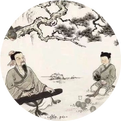↑Click the blue text above to follow us
Life is sustained by Qi, which is the material basis for all life activities. Qi is constantly undergoing self-renewal and replication through metabolic processes. It flows throughout the body, circulating in various organs and meridians, perpetually driving and stimulating various physiological activities. The movement of Qi is expressed through its rising, descending, entering, and exiting. If the movement of Qi is disrupted, it loses its function in sustaining life, leading to the cessation of life activities.
When Qi is not running smoothly, it can lead to a series of pathological changes, such as Qi stagnation, Qi counterflow, Qi sinking, and Qi collapse.
What is Qi Stagnation?
Qi stagnation refers to pathological changes caused by the obstruction of Qi movement. When Qi is not flowing smoothly, it becomes stagnant, often due to emotional distress, phlegm, dampness, food accumulation, blood stasis, or dysfunction of the organs. It can also occur when Qi deficiency leads to insufficient movement, presenting clinically as a feeling of fullness, distension, or pain.
The movement of Qi is closely related to the functions of the liver (which governs the smooth flow of Qi), lungs (which disperse and descend Qi), spleen (which raises clear Qi), stomach (which lowers turbid Qi), and intestines (which separate and transport). Therefore, Qi stagnation is often associated with dysfunction in these organs.
Since the liver governs the smooth flow of Qi, Qi stagnation is most commonly associated with liver Qi stagnation.
What is Qi Stagnation Syndrome?
The main symptoms of Qi stagnation syndrome include localized distension and pain that can vary in intensity and location, often accompanied by sharp or wandering pain, and a feeling of fullness that may be relieved by belching or passing gas, often linked to emotional factors. Secondary symptoms may vary depending on the location, nature, and cause of the condition.
In cases of liver and gallbladder Qi stagnation, symptoms may include emotional depression, distension and pain in the lower abdomen and flanks, chest tightness, and a sensation of a lump in the throat (plum pit Qi);
If Qi stagnation leads to phlegm, symptoms may include headaches, dizziness, and facial flushing;
In cases of liver and stomach Qi stagnation, symptoms may include epigastric and abdominal pain, often radiating to the flanks, or presenting as wandering pain, frequent belching, and sour regurgitation;
In cases of intestinal Qi stagnation, symptoms may include abdominal pain, unsatisfactory bowel movements, and a feeling of urgency without the ability to pass stool;
In cases of liver Qi stagnation with spleen deficiency, symptoms may include borborygmi and diarrhea, with pain alleviating after bowel movements, and increased irritability;
When Qi stagnates in the chest, symptoms may include chest pain that is sharp and variable, pain exacerbated by breathing or movement, or a feeling of tightness and constriction in the chest, which may radiate to the shoulders and arms, leading to difficulty breathing;
When Qi stagnates in the lower back, symptoms may include fullness and pain in the lower back, radiating to the abdomen and flanks, with a sensation of Qi moving erratically;
When Qi stagnates in the superficial meridians, it may present as widespread pain that is variable in location;
In women, symptoms may include breast distension and pain, dysmenorrhea, irregular menstruation, or even amenorrhea, with menstrual flow being sluggish and obstructed.
Cold-induced stagnation may present as severe pain that is relieved by warmth and pressure;
Heat-induced stagnation may present as localized distension and pain, thirst with a preference for cold drinks, and yellow urine with constipation.
The key diagnostic points for Qi stagnation include localized distension and pain, often accompanied by emotional distress, dietary irregularities, physical strain, or a history of cold accumulation.
Clinical manifestations of Qi stagnation vary by location, and treatment methods differ accordingly. In my clinical practice, I frequently encounter patients with liver Qi stagnation. I once treated a 37-year-old female patient who experienced Qi stagnation due to an unpleasant relationship with her mother-in-law. Her symptoms included pain in the chest and flanks, breast distension, bitter taste in the mouth, poor appetite, insomnia, a dark red tongue, and a slightly greasy white coating. The prescription was as follows:
Vinegar Bupleurum (Cu Chai Hu) 12g, White Peony (Bai Shao) 15g, Honey-fried Licorice (Zhi Gan Cao) 6g, Stir-fried Bitter Orange Peel (Chao Zhi Ke) 15g, Cyperus (Xiang Fu) 15g, Chuanxiong (Chuan Xiong) 12g, Green Tangerine Peel (Qing Pi) 15g, Stir-fried Atractylodes (Fu Chao Cang Zhu) 10g, Fermented Wheat (Shen Qu) 20g, Charred Gardenia (Jiao Zhi Zi) 10g, He Huan Pi (He Huan Pi) 30g, Stir-fried Barley (Chao Mai Ya) 30g, etc.
I used a modified version of Chai Hu Shu Gan San (Bupleurum, White Peony, Stir-fried Bitter Orange Peel, Honey-fried Licorice, Chuanxiong, Cyperus, and Aged Tangerine Peel) combined with Yue Ju Wan (Atractylodes, Chuanxiong, Cyperus, Shen Qu, and Gardenia). Chai Hu Shu Gan San is based on Si Ni San, replacing bitter orange with bitter orange peel, and adding Cyperus, Chuanxiong, and Aged Tangerine Peel. Si Ni San is the primary formula for regulating Qi and is a traditional formula for soothing the liver and regulating Qi, serving as a foundational formula for harmonizing the liver and spleen. The addition of Cyperus, Chuanxiong, and Aged Tangerine Peel enhances the effects of soothing the liver and regulating Qi, alleviating pain and promoting blood circulation, which is very effective for liver Qi stagnation leading to Qi obstruction. The patient’s liver Qi stagnation affected the spleen’s ability to transform and transport, leading to poor appetite. I used a modified version of Yue Ju Wan to resolve the six stagnations: Qi stagnation, blood stagnation, phlegm stagnation, fire stagnation, damp stagnation, and food stagnation. Yue Ju Wan has the effect of regulating Qi and resolving stagnation, primarily treating chest and flank fullness, epigastric and abdominal pain, sour regurgitation, nausea, vomiting, and poor digestion. The combination of these two formulas strengthened the effects of soothing the liver, resolving stagnation, regulating Qi, and alleviating pain, resulting in significant improvement after one week of treatment. After improvement, I advised the patient to manage her emotions and, based on her constitution, to nourish liver blood or tonify Qi and blood to enhance her vital energy, making it easier for her to avoid anger.
Regarding Qi stagnation, there are many formulas and herbs available for treatment in clinical practice. For example, Jin Ling Zi San has the effects of regulating Qi, soothing the liver, and promoting blood circulation to alleviate pain; the patent medicine Shu Gan Granules (Dang Gui, Wine White Peony, Vinegar Bupleurum, Vinegar Cyperus, Stir-fried Atractylodes, Poria, Stir-fried Gardenia, Moutan, Mint, and Licorice) also has the effects of soothing the liver, regulating Qi, and resolving stagnation to regulate menstruation; Xiao Yao Wan has the effects of soothing the liver, resolving stagnation, tonifying the spleen, and nourishing blood; Ban Xia Hou Po Tang has the effects of regulating Qi, dispersing nodules, and descending rebellious Qi to resolve plum pit Qi; Guo Lou Xie Bai Bai Jiu Tang has the effects of unblocking Yang, dispersing nodules, and regulating Qi to eliminate phlegm, which can treat Qi stagnation in the chest; and Qi Stagnation Stomach Pain Granules have the effects of soothing the liver, regulating Qi, and harmonizing the stomach to alleviate pain from liver and stomach Qi stagnation.
Wang Mian Zhi once said, “Qi is the treasure of the human body; it should not be harmed but nourished. Whether in descending rebellious Qi or regulating Qi to resolve stagnation, one should not seek immediate results by using large amounts, as this can easily harm Qi, leading to other diseases.” Therefore, when treating stagnation, it is essential to clarify whether the Qi is sufficient or deficient based on the patient’s overall condition. The dosage of herbs should be adjusted according to the patient’s constitution and the nature of the disease, allowing for appropriate increases or decreases in dosage to ensure that Qi is regulated without being harmed, thus achieving a comprehensive treatment approach.
The Ma Chun Yang Traditional Chinese Medicine team is composed of inheritors of the Jiang You school, led by the master who selected outstanding practitioners from thousands of doctors. They follow the four principles of heaven, earth, humanity, and Qi in treating diseases, guided by the five movements and six Qi in clinical practice, and use Yin-Yang and six methods for differential diagnosis and treatment. For consultations, please scan the QR code below:

Previous Highlights:
1. Is it necessary to take ginseng and donkey-hide gelatin for Qi and blood deficiency? Do you want to know a good formula for tonifying Qi and blood?
2. Did you know? The liver houses the soul, and if liver Qi is not smooth or liver blood is insufficient, it can affect sleep?
3. How do different emotions like happiness, anger, fear, and sadness affect health? You will know after reading this!
4. The liver does not like anger; it prefers smoothness and clarity. How is your liver doing?
5. If liver Qi is not smooth, and there is a sensation of a foreign body in the throat, beware of “plum pit Qi!”
6. Is it necessary to tonify the kidneys for frequent nighttime urination? Do you want to know a good method?
7. If a child does not want to eat and frequently gets sick, is tonifying the spleen enough?
8. A 7-year-old child with precocious puberty improved after taking Ban Xia Xie Xin Tang for a few days.
9. How is your menstruation? Women rely on blood; regulating menstruation not only makes you look younger but also enhances your health!

